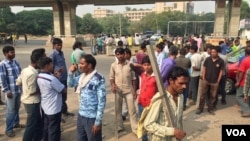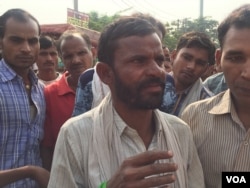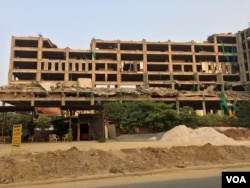India’s main Hindu festival of lights is just days away, but there is little cheer for 35-year-old Kali Charan. For a week, the daily-wage laborer has hung on the side of a busy street intersection in the business hub of Gurgaon hoping that building contractors or home owners will stop by to seek his services.
He is not alone. This is the spot where scores of other unemployed laborers gather daily in search of work as masons, carpenters, painters and plumbers.
But Kali Charan is finding far less work than he did eight years ago when he migrated from his village. “I get work only for ten or fifteen days a month,” he said despondently. “I try to manage in as little as possible to save a few dollars to send home to my village.”
His woes are not surprising. In the last decade, as Gurgaon boomed, massive construction projects created tens of thousands of jobs making it a hotspot for migrant labor.
But many projects have been stalled due to a slowdown in demand. The situation is no different in other parts of the country.
Construction is not the only labor-intensive sector to be struggling. Factories making garments, leather products and other goods for export are also facing tough times due to the global slowdown.
Economist Rajiv Kumar at New Delhi’s Center for Policy Research said the export industry was a massive job creator, but “they (exports) have been declining for continuous 18 months, sector after sector.”
Surveys have shown that thousands of jobs were lost in factories making garments, leather goods and other products for exports in last year.
A recent survey by the government’s Labor Bureau says the unemployment rate rose to a five-year high of five percent.
It is a surprising statistic for an economy that outpaced China to grow at more than seven per cent last year. But economists say India is experiencing what they call “jobless growth.”
“Growth is there, but it is taking place in those sectors where capital intensity is higher, but where labor absorption is not much. So our prediction that the modern, globalized sector would be able to provide employment is not happening,” said Amitabh Kundu, former professor at Jawaharlal Nehru University.
That is not good news for India, the country with the world’s largest population of those under 25. One million people are added to the workforce every year.
The failure to add employment opportunities for these young people poses a huge challenge for Prime Minister Narendra Modi, whose promise to create millions of new jobs catapulted him to power in 2014.
It has been a key focus of his government since he took office. The government has launched a “Make in India” program and liberalized foreign investment rules to woo investors with an eye on expanding manufacturing and employing millions moving out of agriculture.
Some investment has come, but there are no signs that India will be able to emulate China’s success in manufacturing.
Modern factories are also unlikely to create jobs on the scale witnessed some years ago. “In the large corporate sector, because of ongoing automation or call it robotization, companies are tending to replace labor with machines,” points out economist Kumar.
The government has taken other initiatives to create jobs. It has promised loans to small and medium sized businesses, which are more labor intensive, and has started a $1.5 billion fund to encourage start-ups.
But will that be enough? In its Asia-Pacific Human Development Report this year, the United Nations Development warned India faces a huge challenge of finding jobs in the next 35 years for the 280 million people that will enter the job market.
On the ground, that is not hard to see. Seventeen-year-old Nikhil Singh in Gurgaon comes in search of work every day after he quit school after grade nine. “I come here because we need money at home. Sometimes I get work, sometimes I don’t,” he said.
An older man shrugged in resignation – he does not need a study to tell him that the swelling ranks of job seekers are a threat to his livelihood. “When our numbers have increased, work will decrease, wont it?” he said.
Political analysts say while Prime Minister Modi is widely credited with rejuvenating the economy and making India more open for business, his key test lies in finding ways to revive the job market.
Head of New Delhi’s Center of Developing Societies, Sanjay Kumar, points out that the lack of jobs could test the popularity of the ruling Bharatiya Janata Party (BJP). “Lok Sabha (parliament) elections are at a distance, at least two and a half years away. Things might improve, but if we go by the same trend which we find now, this is [an] alarm bell for [the] BJP.”
Finding enough work for India’s young population is a daunting task, said economist Kumar. “Huge is an understatement, can’t find the word, gigantic, gargantuan, whatever, very, very challenging.”











